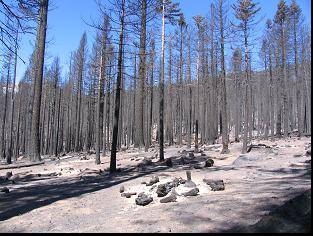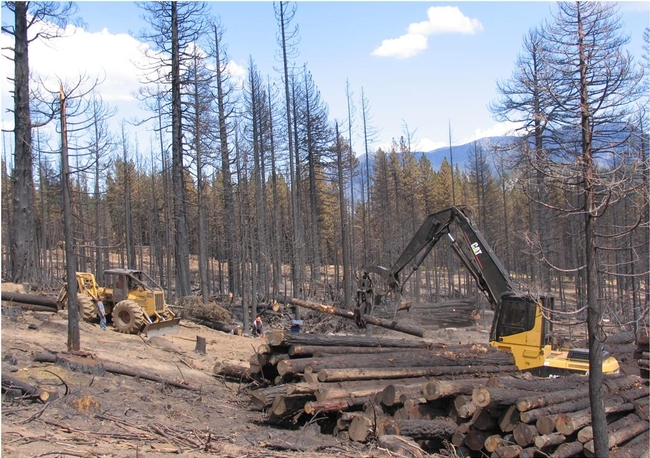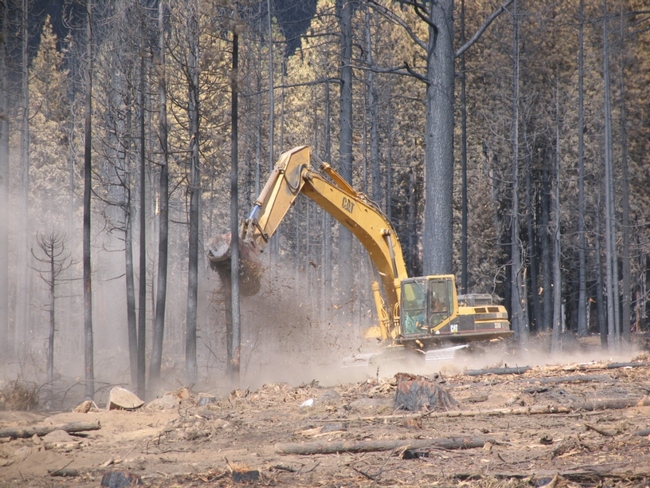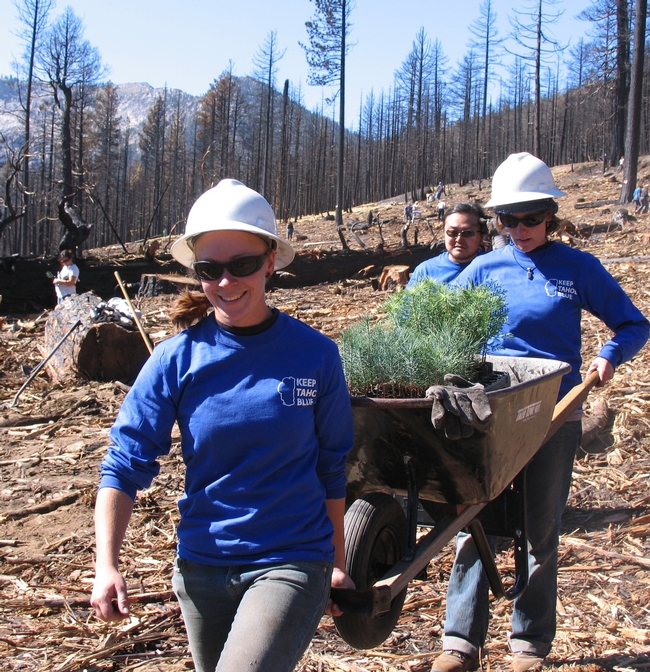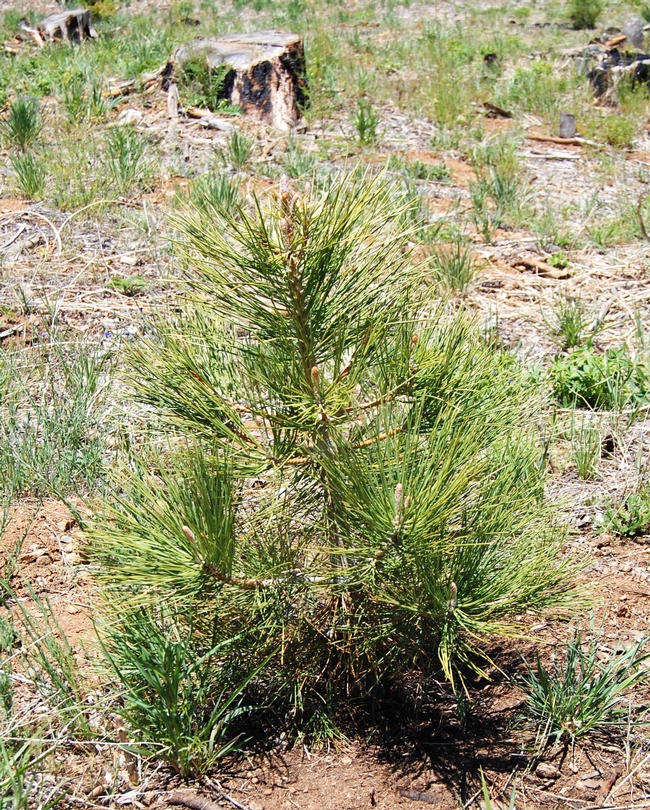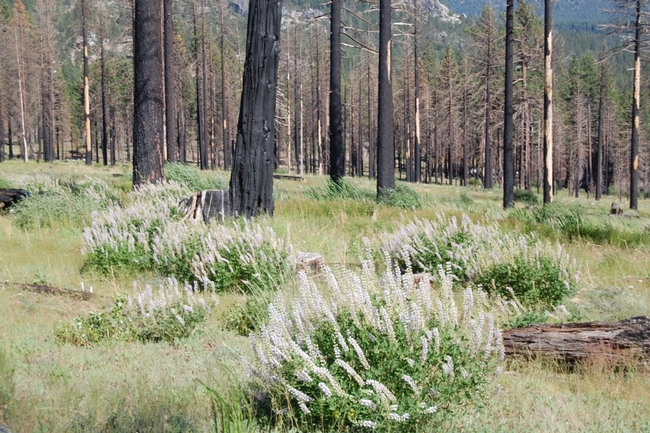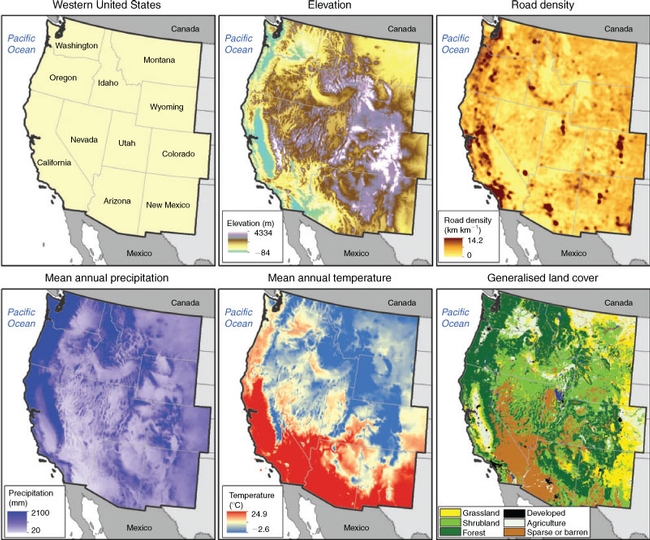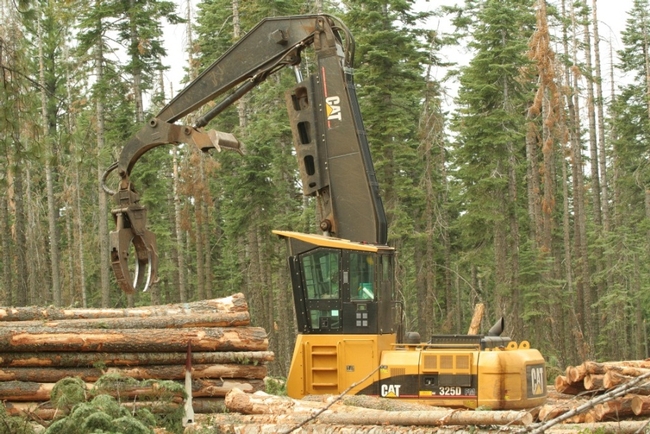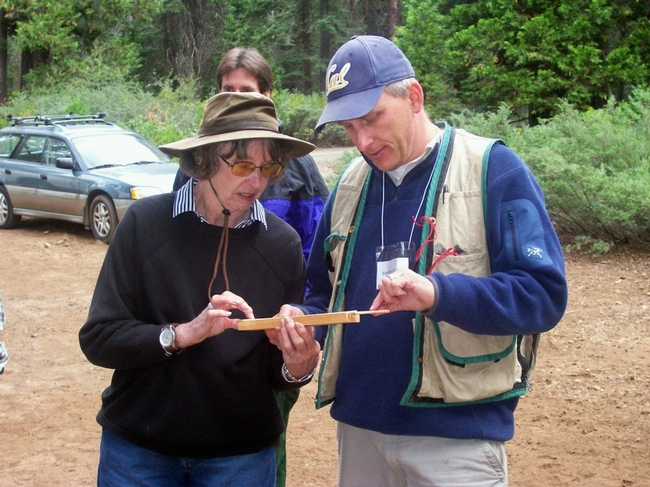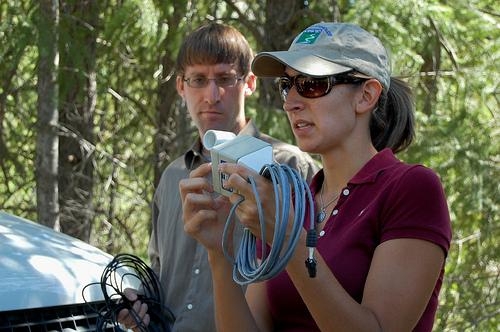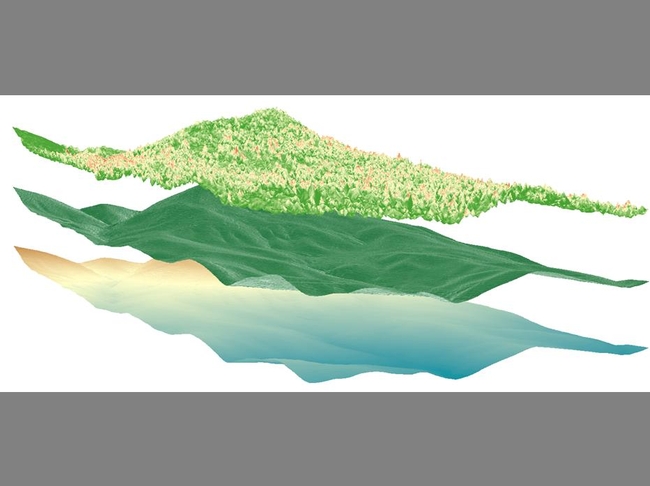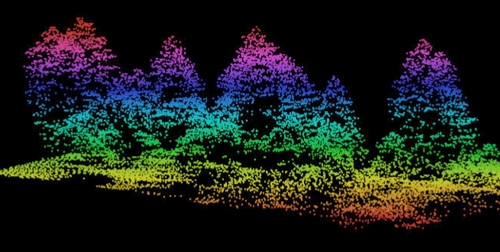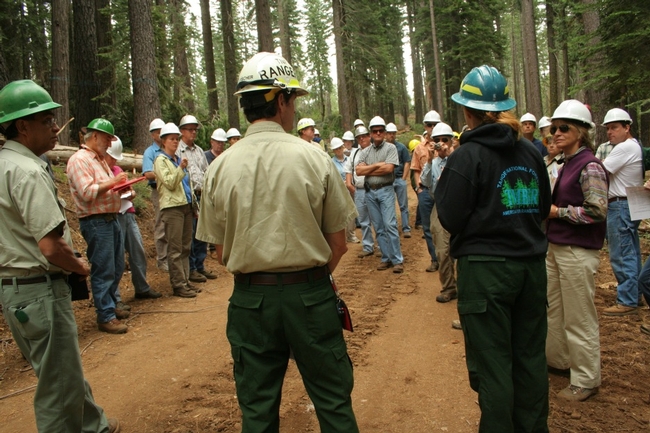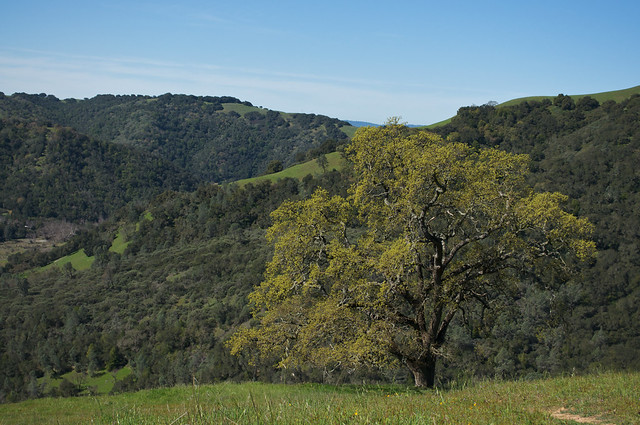Southern Sierra Prescribed Fire and Smoke Symposium
March 26th – 27th 2012 • Clovis, CA
Event Summary
Field Tour - March 26, 2012
High Sierra Ranger District, Sierra National Forest
The half-day field trip scheduled at the Southern Sierra Prescribed Fire and Smoke Symposium last week was snowed out. So participants stayed snug in the High Sierra Ranger District conference room and had a great four-hour conversation. According to the workshop evaluations, it was a good trade: although they missed having a field experience, participants reported wanting more opportunities to share in an open dialog of this kind.

Meeting at the High Sierra Ranger District – Despite being forced inside by weather,
many reported that the four hours of mostly unstructured conversation were productive and useful
Carolyn Ballard, High Sierra Ranger District Fire Management Officer and fire and fuels management specialist on the Dinkey Landscape Restoration Project (CFLRP) led the impromptu dialog. The session opened with Carolyn giving the history of the landscape through a series of photos. Carolyn shared photos of an area on the Sierra National Forest treated with three entries of prescribed fire that is also home to the Pacific fisher. A casual group discussion followed her presentation, covering numerous topics related to prescribed burning and air quality issues. Below are some of the topics of discussion.
General discussion
- Are we burning this landscape at the appropriate intensities?
- What are the acceptable ranges of mortality?
- Are small (3 day) burn windows for prescribed fire forcing fire practitioners to homogenize burns?
- Penalties and fines for ozone exceedances. San Joaquin Valley Air Pollution Control District was fined $29 million dollars for a recent air exceedance and now residents, business, and all registered vehicles are paying ~$12/registered vehicle. How does smoke from wildland fires contribute to ozone levels?
- Summer burn windows are available, but there is usually a draw down on suppression crews due to the wildfire season. What should the staffing levels be in the summer months to allow use of these burn windows?
- In the Great Basin Air Pollution Control District there is low smoke dispersion. The standard is 1-mile visibility for 24 hours. There are many nuisance calls that are made when visibility is in the acceptable range. 80% of the burn days are on marginal days, which are permissive burn days.
- Both San Joaquin Air Pollution Control District and Great Basin Air Pollution Control District charge a fee for burning – Great Basin is an annual flat fee in accordance with Rule 308. More details at http://www.gbuapcd.org/rulesandregulations/PDF/Rule308.pdf. The San Joaquin Valley APCD charges $5.84/acre (blackened) and $3.50/pile/acre.
Limitations identified
- Coordination across agencies needs to take place. Example: A pool of shared funds that would allow agencies to work together on larger landscape burns and also use resources when needed.
- Staffing and Budget constraints
- Need for more education/outreach: both within public agencies and for the general public
- Not enough type 1 fire for keeping up to date with the qualification. Type 1 burns are more complex. For example, a helitorch burn would be considered a type 1 complexity burn.
Needs identified
- Response to climate change in the larger trees. How does our fire management now affect climate change in the future?
- How do we incorporate adaptive management and monitoring to help with the climate change uncertainty?
- Need incentives for allowing fire practitioners to allow fire to burn to man made or natural barriers instead of spending resources to put in a fire line to contain a fire.
- Training and coordination for increased fire qualification and experience – Prescribed Fire Training School
Things that are working
March 26th Keynote Speaker – Evening Social at Di Cicco’s
Rick Sneeuwjagt – Southwest Australia
[Download PDF of presentation]
Rick Sneeuwjagt retired from the position of Principal Fire Projects Officer with the Department of Environment and Conservation (DEC) in southwestern Australia in December 2011, after moving on in May 2010 from his previous post as the State Manager for Fire Management Services for the DEC, a position he has held since 1994. The DEC is responsible for the fire and land management of about 115 million hectares of conservation lands throughout Western Australia.
In his keynote address, Rick presented on the extensive prescribed burning program in southwestern Australia. The DEC uses large scale prescribed burns (generally ranging from 1000 to 6000 acres in size) to reduce wildfire severity and threats to communities at the landscape scale, as well as to maintain biodiversity for a wide range of species. Rick’s team coordinates closely with researchers within the DEC to monitor the effectiveness of their treatments, and runs an outreach program designed to demonstrate the effectiveness of their prescribed fire treatments to rural and urban communities and politicians. For more information, contact Rick Sneeuwjagt at Rick.Sneeuwjagt@dec.wa.gov.au
March 27th – Clovis Memorial Veteran’s Hall
Southern Sierra Prescribed Fire and Smoke Symposium
About 80 people were in attendance at Tuesday’s symposium, representing numerous disciplines from the Forest Service, the National Park Service, NGOs, universities, the EPA, the California Air Resources Board, and the San Joaquin Valley, Great Basin, Mariposa, Tuolumne, and Monterey Air Pollution Control Districts. The symposium featured a number of presentations describing the ecological need for increased prescribed fire as well as the regulatory framework that manager’s face in implementing prescribed burns. These presentations were followed in the afternoon with breakout discussion sessions to identify the barriers, needs, and opportunities to collaborate around prescribed fire and smoke issues in the southern Sierra Nevada region, as well as the role that a Prescribed Fire Council could play to help take advantage of those opportunities.

Breakout groups discuss barriers, needs, and opportunities for collaboration around
prescribed fire and smoke issues in the southern Sierra Nevada region.
Featured Presentations
Malcolm North, Pacific Southwest Research Station and UC-Davis
Using fire to increase the scale, benefits and future maintenance of fuels treatments
Malcolm North is a research ecologist with Pacific Southwest Research Station and an associate professor at UC Davis. Malcolm gave an overview of new research he is working on with Brandon Collins (USFS PSW and UC Davis) and Scott Stephens (UC Berkeley). His presentation framed the roadblocks that the large-scale use of prescribed fire and managed wildfire faces in California forests. He outlined historic fuels reduction compared to current fuels reduction, the decline of ecological and economic benefits as fuel reduction is postponed, how to use stretch goals and backcasting to achieve restoration and a desired future condition. Malcolm emphasized that the only effective means of restoring and maintaining California’s forest must include prescribed and managed fire, and provided recommendations regarding how constraints on burning may be overcome in the future. For more information, Malcolm can be contacted at mnorth@ucdavis.edu
Don Hodge, Federal Environmental Protection Agency
Summary of EPA Fire Policy and Exceptional Events Rule
[Download PDF of presentation]
Don Hodge has been with the Pacific Southwest Region office of the EPA since 1994. Don gave a summary of the Exception Events Rule, which is a process to “exclude monitored exceedances of the National Ambient Air Quality Standards from consideration when designating an area as nonattainment” relative to those standards. Don’s presentation outlined the basics of the National Ambient Air Quality Standards, the process to exclude or include NAAQS attainment, and described the characteristics of an air quality exceedance event that would qualify under the Exceptional Events Rule. For more information on the Fire Policy Process, Don can be reached at Hodge.Don@EPA.gov or by phone at (415) 972-3240. For more information on Exceptional Events, contact Katherine Hoag, Air Quality Analysis Office at Hoag.Katherine@EPA.gov or by phone at (415) 972-3970.
Dar Mims, California Air Resources Board
The California Smoke Management Program as a Response to EPA Policy
[Download PDF of presentation]
Dar is the Air Pollution Specialist for the California Air Resources Board. Dar presented an overview of the Health and Safety Code as they relate to the smoke management guidelines of Title 17 of the California Code of Regulations. Dar also summarized the current cooperation of CARB with local air pollution control districts through smoke management plans, air monitoring and meteorological data, and models for evaluating data and making burn day decisions. His presentation emphasized that the California Air Resources Board is committed to continued relationships with stakeholders and improving outreach and education. For more information Dar Mims can be contacted via email at dmims@arb.ca.gov
Shawn Ferreria, San Joaquin Air Pollution Control District
San Joaquin Air Pollution Control District Rules and Operation as a Response to the California Smoke Management Program
[Download PDF of presentation]
Shawn is the Senior Air Quality Specialist for the San Joaquin Air Pollution Control District, which has a jurisdiction of over 25,000 square miles in 8 counties. Shawn presented on the challenges the air district faces with nonattainment for ozone and PM 2.5 and the overall district strategy on prescribed burns and wildfires. Shawn discussed the decision-making process as it relates to burning through seasonality, size, minimizing smoke emissions, location, cumulative impact, and public messaging. Shawn also introduced an ongoing collaborative effort to address the challenges faced by the air district through working closely with land managers and monitoring local and regional smoke impacts. For more information Shawn can be reached at shawn.ferreria@valleyair.org or by phone at (559) 230-5823.

Shawn Ferreria, Senior Air Quality Specialist at the San Joaquin Valley APCD,
presents on compliance issues faced by his district.
Nick Goulette, Hayfork Watershed Research and Training Center
Exploring the Role of Prescribed Fire Councils – Lessons from Northern California and Beyond
[Download PDF of presentation]
Nick is the Director of the Hayfork Watershed Research and Training Center, the co-chair of the Northern California Prescribed Fire Council, and is also involved with the Klamath-Sisykiou Fire Learning Network. Nick presented a summary of issues around increasing the use of prescribed fire and how a Prescribed Fire Council in northern California and other parts of the country are coordinating to overcome the complexities of increased prescribed fire use. Nick’s presentation highlighted the successful collaboration and collective actions of other Prescribed Fire Councils through their “One message, many voices” outreach campaigns. For more information on these messaging campaign visit www.visitmyforest.org and www.goodfires.org. Prescribed Fire Councils are quickly becoming a national organizing force and a national voice for prescribed fire use. Please visit www.prescribedfire.net for additional information on the National Coalition for Prescribed Fire Councils and for more information on the Northern California Prescribed Fire Council visit http://thewatershedcenter.farming.officelive.com/default.aspx. Nick can be contacted at nickg@hayfork.net and by visiting www.thewatershedcenter.com
Brent Skaggs, USDA Forest Service, Sequoia National Forest
Lion Fire Lessons Learned and the Value of Webcams for Monitoring Wildfire
[Download PDF of presentation]
Brent Skaggs is the Forest Deputy Chief on the Sequoia National Forest. Brent gave an overview of the 2011 Lion Wildland Fire in the Golden Trout Wilderness. The Sequoia National Forest is unique because of the webcams that are available on the forest and were used on the Lion Fire to monitor smoke dispersion in surrounding communities. Brent showed a series of slides, including distant views of smoke as well as close up views along the same ridgelines in different areas. The use of webcams gave the forest and the air district the ability to monitor in real time – a valuable tool in monitoring smoke from wildfires. For more information contact Brent at bskaggs@fs.fed.us.
Leland Tarnay, National Park Service, Yosemite National Park
Post-fire Smoke Documentation, Real Time Monitoring and Exceptional Events
[Download PDF of presentation]
Leland is the Physical Scientist and Air Resource Specialist for Yosemite National Park. He presented on the post-fire smoke documentation and monitoring data in Yosemite National Park. Specific topics Leland covered included: daily emissions monitoring on the Tamarack Fire, particulate matter measurements, webcam use, MODIS, and the Hazard Mapping System to help in monitoring fires and smoke in Yosemite National Park. The work that Leland is doing in the park has many practical applications, including public buy-in, operational decisions, and compliance with NAAQS and Title 17. The long-term goals of Yosemite are to build a knowledge base for smoke behavior in the park’s watersheds and to help build resilient landscapes that allow for more opportunity to manage fires. For more information contact Leland at Leland_Tarnay@nps.gov
The group stops to discuss in a gap - note the large legacy trees in the foreground opening, with denser groups of smaller trees in the background.One of the main goals of the project is to try to recreate a similar variable stand structure to what was found in the central Sierras prior to fire suppression and logging. In 1929 an inventory was taken of the same STEF lands for a “methods of cutting study”. Then, much of the forest area exhibited distinct gaps and patches of trees - separate groups of trees each with similar density, basal area, and canopy cover, along with gaps of understory vegetation with little to no trees mixed in to the overall stand.
Knapp discussing marking protocols in an untreated control unit.Knapp and Benech emphasized that the marking guidelines are flexible – “this means few black and white decisions and no right or wrong answers, which was initially frustrating for some.” Often, certain stand characteristics such as remnant black oaks, root disease pockets, or legacy trees would be used as “anchors” to plan around. This fluid approach draws a contrast to the standardized thin-from-below treatments commonly used in traditional thinning projects. While more time-consuming at first, as the crews become more experienced at marking these complex treatments the rate of marking progress grew closer to the rate for more traditional treatments.
Sierra NF Wildlife Biologist and Climate Change Coordinator Greg Schroer discusses burn implementation and the creation of wildlife habitat while the group stops in a treated old growth standOutreach
Open tree crowns and retained snags in a treated unit.
A retained snag, in the center of the photo behind the group, shows large woodpecker holes.

